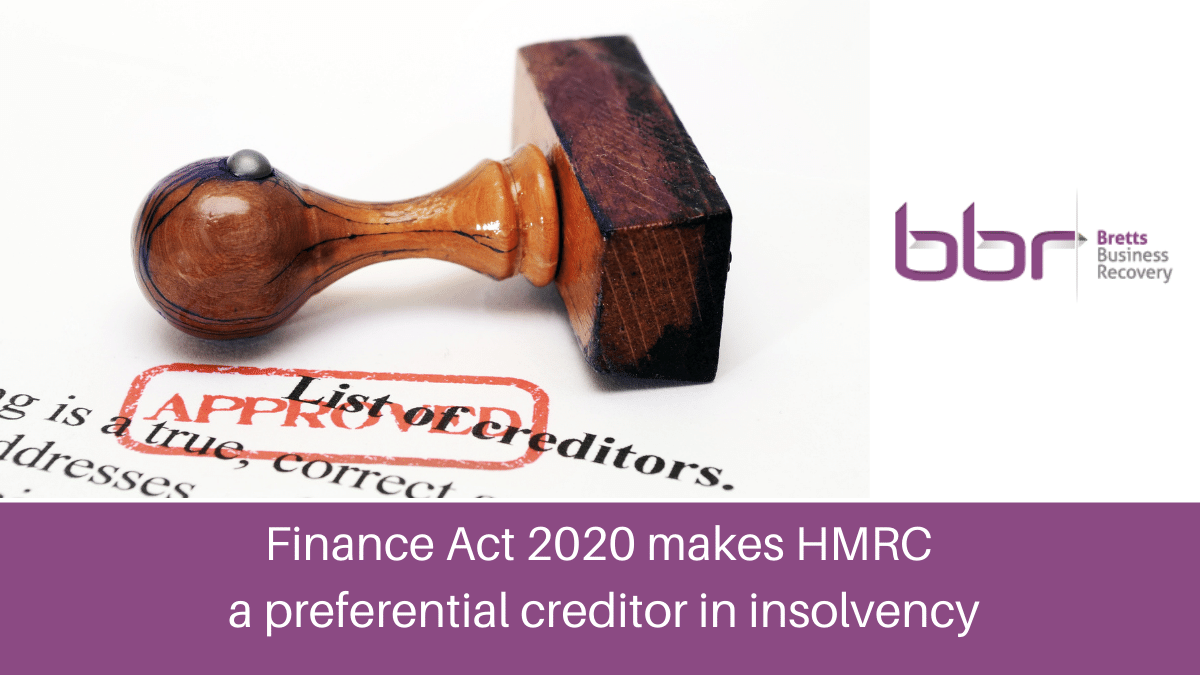Finance Act 2020 gives HMRC priority pass in insolvency

The Finance Act 2020 received Royal Assent on 22 July, confirming that from 1 December 2020 HMRC will become a secondary preferential creditor in insolvencies.
This is a disappointing announcement for the insolvency industry which believes the proposals to revert to preferential creditor status fly in the face of recent efforts to support business and economic recovery and should have been scrapped altogether.
As businesses struggle to recover to normal levels of revenue, it is increasingly likely that many will be amassing debts. With temporary business support measures set to end towards the close of 2020, it’s likely we’ll see a spike in insolvencies later this year and into 2021.
What is the effect of the legislation?
The changes will move HMRC up the rankings – enabling the Government to collect more tax from insolvent companies and individuals. All good for HMRC, probably at a time they need it most, but this leaves the average unsecured trade creditor with an even smaller slice of the pie.
From 1 December 2020, when a business enters insolvency, HMRC will become a secondary preferential creditor for taxes collected and held by the business on behalf of other taxpayers. These include VAT, PAYE Income Tax, employee National Insurance contributions, student loan deductions and Construction Industry Scheme deductions.
HMRC will remain an unsecured creditor for taxes owed by businesses themselves, such as for Corporation Tax and employer National Insurance contributions.
As a consequence, funding is likely to become more onerous and may carry increased personal risk. Banks now fall behind HMRC’s claim in an insolvency situation and thus may be less inclined to offer finance on a floating charge basis. They are also more likely to require personal guarantees from directors in support of lending to their companies.
The new order of creditors
The order in which creditors recover their debts in insolvency is set out in The Insolvency Act 1986 and was recently updated with the enactment of the Finance Act 2020.
The ranking order which specifies how asset realisations are paid out is:
- Secured fixed charge creditors (e.g. leasing companies, banks and other lenders holding security over specific assets. If a bank has a debenture, incorporating a fixed and floating charge, the assets caught here by the fixed charge may include freehold buildings or large fixed items of plant etc.)
- Ordinary Preferential creditors (e.g. employees entitled to unpaid wages, and deposits that fall within the Financial Services Compensation Scheme (FSCS))
- Secondary preferential creditors – HMRC (to include VAT, PAYE (including student loan repayments), Employee NICs and CIS deductions).
- Prescribed part creditors (fund ring-fenced to pay a limited dividend to non-preferential unsecured creditors)
- Secured floating charge creditors (if a bank has a debenture, incorporating a fixed and floating charge, the assets caught here by the floating charge may include assets such as stock, raw materials, work-in-progress, etc))
- Non-preferential unsecured creditors (e.g. trade creditors, suppliers, customers, contractors, some employee claims plus all other HMRC taxes not listed in 3).
- Shareholders or individual (people who have invested in the business)
In summary, fixed charge assets will go firstly to pay the respective fixed charge creditors.
Floating charge assets are firstly made available to preferential creditors and any surplus available will then be made available to the other classes of creditor, in the above order of ranking. Subject of course to the cost of the insolvency proceedings.
The reinstatement of crown preference is unfavourable for ordinary unsecured creditors and holders of floating charges, who will be paid after HMRC’s PAYE NIC and VAT liabilities have been met.
What next
This provision, which sees HMRC jump ahead of floating charge creditors and unsecured creditors, continues to be opposed by the UK insolvency and restructuring profession, led by R3, who believe it will damage the UK’s carefully cultivated business rescue culture.
Directors have a duty of care to act in the best interests of all creditors. Contact us for advice on what options are available to you as a creditor or as a director struggling to manage debt.